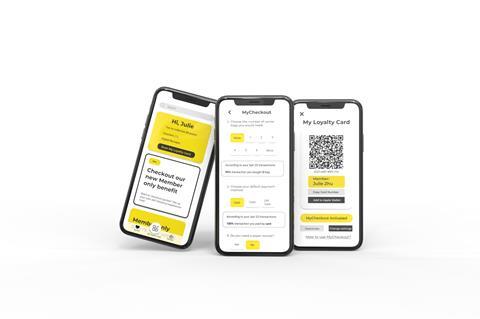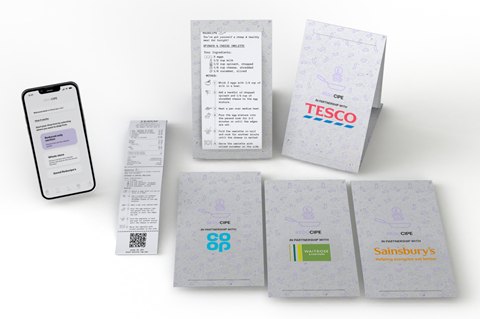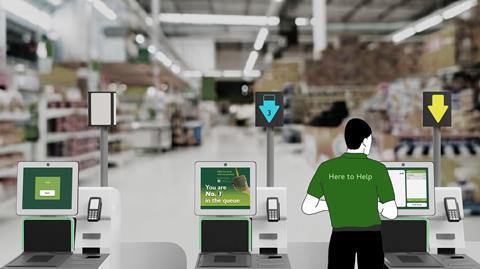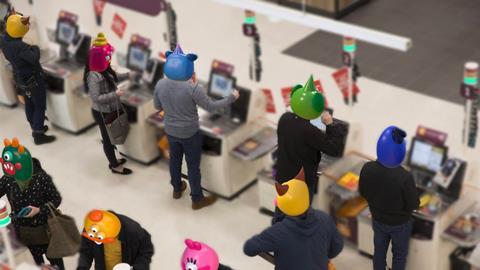Supermarkets love self-checkouts. They offer significant savings on labour costs, boosting the bottom line. And despite the noisy protests of a minority, most customers love them too.
An industry source tells The Grocer around 80% of sales in a typical supermarket now go through SCOs. As Tesco CEO Ken Murphy told shareholders last year: “We genuinely believe, at the end of the day, it provides a better customer experience.”
But SCOs are far from perfect
Shrinkage is an issue, which is only intensifying in the cost of living crisis. ECR Retail research from 2018 found a store with half of transactions going through fixed SCOs can expect shrinkage losses to be 77% higher than the average rate. Store staff frequently bemoan them. And there is a sense the often clunky user journey is eroding the overall customer experience – prompting high-end grocer Booths to last year announce it was stripping them from all but two of its stores. “We’re not great fans of self-checkouts,” Booths MD Nigel Murray told The Grocer. “We pride ourselves on great customer service and you can’t do that through a robot.”
Can some simple design tweaks overcome their shortcomings? That was the challenge put to students on the Design Against Crime (DAC) and the BA Product and Industrial (BAPID) course at University of the Arts London: Central Saint Martins by ECR Retail Loss.
Their task – carried out with input from experts at Co-op, Sainsbury’s, Tesco, Waitrose and NCR, and drawing on ECR’s wealth of research on SCOs – was to apply human-centred design to drive up SCO usage, reduce retail losses, and improve the experience for staff and customers. And, crucially, make the designs easy and economically feasible to roll out.
“We were looking not necessarily to reimagine the checkout and come up with really high-tech solutions,” explains Jeff Doruff, project co-ordinator for Design Against Crime Research Lab. “We know retailers buy these machines, and they have 10-year life cycles. We were looking at pragmatic, feasible solutions.
“The students were given the job to reframe a difficult situation – and make it a positive,” adds Dr Lorraine Gamman, professor of design at Central Saint Martins. “We call it sideways thinking. How do you come to this problem in a different way? We go through all the obvious things – get a guard dog. Get a bigger guard dog. Then you go right round until you address the human factors.
“But the retailers can’t get rid of their machines in a hurry. So how do we enhance what exists?” she adds.
Here are the top five designs emerging from the challenge:
MyCheckout

Designer: Lizixi Zhu
Customers can input their self-checkout preferences, such as bagging options, payment method, and screen layout via a supermarket’s loyalty app. At the checkout, a simple scan of their physical or in-app loyalty card configures the machine to their personalised set-up in an instant.
The design not only fosters use of the loyalty card – which has been linked to reduced theft – but eases the whole checkout experience to “reduce the motivation for theft and provocation for abusing the system”.
Retailer feedback:
“We just launched a large online platform. There’s the possibility of using everything that is saved on your loyalty setting also as an online option. A design like this would promote the online channel. I see this as something we should aim for as I see this as the next logical step – to launch something like that. We are quite big on loyalty – what we know in terms of shrinkage is that our loyalty customers produce less shrinkage.”
Checkout Avatar

Designer: Liyang Bao
As shoppers are at the self-checkout they can see themselves on a CCTV screen, but with their faces overlaid with augmented reality avatars. The design “transforms routine surveillance into a game-like experience that’s culturally sensitive and seeks to mitigate bias”.
The avatars can even display animated timers, showing how long each customer has been at the checkout. The design emphasises the oversight in place, deters offenders through self-awareness, but all in a fun way while maintaining customer privacy.
Retailer feedback:
“For the topics of privacy and GDPR, it’s a nice solution, but also adding friendliness and fun, It’s not punitive, it’s not ‘we’re watching you’.”
“What I liked about this is it would draw your attention to a monitor… Now that you have their attention, there needs to be some verbiage on the screen that they are being recorded and viewed.”
Fast & Less Furious

Designer: Jan Herbst
When a customer hits a snag in the checkout process – be it an ID check, age verification or unrecognised item – the store colleague on hand simply scans the appropriate barcode, taking them straight to the relevant screen. This means they can engage face to face with the customer “ensuring that interventions become opportunities for meaningful interactions rather than barriers to efficiency”.
It uses barcodes uniquely generated and assigned to each store colleague and readily printed at the till – housed in a cheap, sleek credit card-sized holder.
The result is a much improved, speedier customer experience with less frustration and waiting around – and a more personal touch when help is needed.
Retailer feedback:
“The design plays with the sensory organ with the simple raised edge on the barcode holder that helps the employee quickly identify [which barcode they are using], allowing them to keep eye contact and engagement with the customer. That was a simple and genius way to drive engagement differently.”

Reducipe

Designer: Lulu Lawrence-Mills
As customers pay at the self-checkout, the Reducipe system analyses their basket contents and displays tailored recipes on screen and printed on receipts. It’s aimed at cusrtomers facing financial constraints and “not only provides immediate value and supports budget-friendly meal planning, but also keeps the customers’ attention fixed on the screen”, in turn reducing the likelihood of unintentional walkouts during payment processing.
An app-based version of the design allows shoppers to be served with recipe ideas based on their purchases as they shop in the aisles or by taking a photo of a shelf display, ultimately “demotivating theft by helping customers reduce costs”.
Retailer feedback:
“It takes a completely different lens to how everyone else has looked at [the challenge].”
“When we’re talking about intervention, frustrations and aggression against employees, this would be great actually.”

Ease Lighting

Designer: Shuhui Yang
Waiting for assistance at a self-checkout is incredibly frustrating, made even more so if help comes after other shoppers who may have requested it after you.
This intelligent lighting system indicates customers in need – and in the right order – with different coloured arrows, which also signal to staff which issues will need to be sorted when they get there, so they can “approach with the right solution in mind”.
While they wait for help to come, customers are told their place in the queue and served with on screen games or other entertainment, reducing frustration and the chance of walkouts or disputes.
Retailer feedback:
“What is really good is that as a customer you feel recognised. You feel that someone is coming to you. Also, well thought out about the colours, when you consider the accessibility act for people that are colour blind.”


























No comments yet